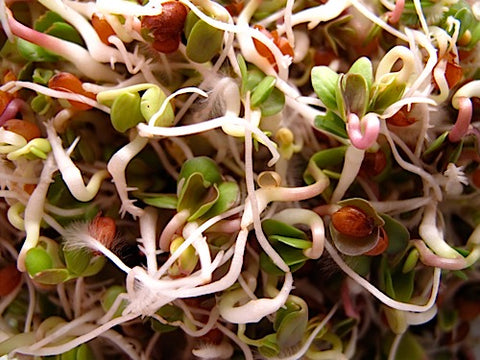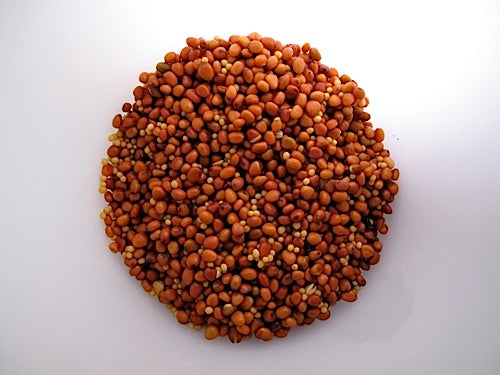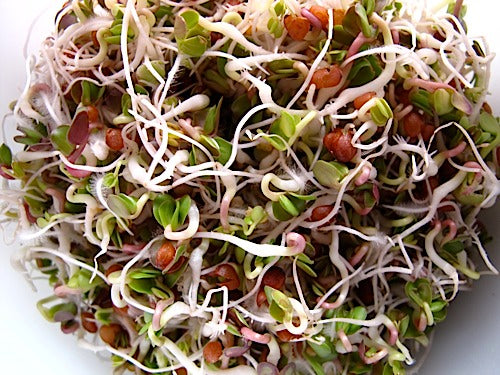





Hot Squared Sprout Mix
Daikon Radish & Oriental Mustard
How much more hot can it get? None more Hot! The spiciest Brassicas come together to create the very tasty Hot Squared! For those who didn't know: 2 = Squared. It's a math thing - you knew that, didn't you?.
How to Grow Hot Squared Sprout Mix
- Soak 3 Tbs. of seed in cool water for 4-12 hours.
- Drain off soak water. Do not ever soak again.
- Rinse thoroughly.
- Drain Thoroughly.
- Rinse and Drain with cool water every 8-12 hours.
- On day 3, move your Sprouter to indirect sunlight.
- Continue to Rinse and Drain every 8-12 hours.
- Harvest on day 5 or 6, when the leaves are open and most of them are green.
- De-Hull your crop if you like, before Refrigerating.

Dry Hot2 Ready to Soak.

12 hours later... Soaked, Rinsed andDrained thoroughly.

12 hours later... Another Rinse/Drain cycle.

12 hours later... Another Rinse/Drain cycle.

12 hours later... Another Rinse/Drain cycle.

12 hours later... Another Rinse/Drain cycle.

12 hours later... Another Rinse/Drain cycle. When you look at your sprouts - 12ish hours since you last looked at them - you will see fuzz on them. That is not mold! You are seeing microscopic roots: Root Hairs. You may have seen them earlier, and you'll see them in the future. Rinsing makes them fall back against the tap root. They seem to disappear, but as the sprouts dry - in the next 12 hours - they unfurl again as you will see. You should see them with a Magnifying Glass. Amazing!

12 hours later... Another Rinse/Drain cycle.

12 hours later... Another Rinse/Drain cycle.

12 hours later... Another Rinse/Drain cycle.

12 hours later... Harvest Time!

Dry Hot2 Ready to Soak.

12 hours later... Soaked, Rinsed andDrained thoroughly.

12 hours later... Another Rinse/Drain cycle.

12 hours later... Another Rinse/Drain cycle.

12 hours later... Another Rinse/Drain cycle.

12 hours later... Another Rinse/Drain cycle.

12 hours later... Another Rinse/Drain cycle. When you look at your sprouts - 12ish hours since you last looked at them - you will see fuzz on them. That is not mold! You are seeing microscopic roots: Root Hairs. You may have seen them earlier, and you'll see them in the future. Rinsing makes them fall back against the tap root. They seem to disappear, but as the sprouts dry - in the next 12 hours - they unfurl again as you will see. You should see them with a Magnifying Glass. Amazing!

12 hours later... Another Rinse/Drain cycle.

12 hours later... Another Rinse/Drain cycle.

12 hours later... Another Rinse/Drain cycle.

12 hours later... Harvest Time!
Yields approximately 3 Cups (1/2 lb.) of Sprouts
Prep 3 Tablespoons of seed* then transfer (if necessary) into a bowl or into your Sprouter. Add 2-3 times as much cool (60°-70°) water. Mix seeds up to assure even water contact for all. Note: Brassicas tend to float. Try to sink those that do by knocking them down with your fingers. It isn't a big deal but it is a good habit.
Allow seeds to Soak for 6-12 hours. Empty the seeds into your Sprouter (if necessary). Drain off the soak water. You may water plants or use it in stock if you like - it has nutrients in it. Rinse thoroughly with cool (60°-70°) water. Drain thoroughly!
Set your Sprouter anywhere out of direct sunlight and at room temperature (70° is optimal) between Rinses. This is where your sprouts do their growing. We use a counter top - in the corner of our kitchen, but where the sprouter won't get knocked over by cats, dogs, kids or us. We don't mind the indirect sunlight or the 150 watts of incandescent light, because light just does not matter much. A plant can only perform photosynthesis when it has leaves. Until a plant has leaves, light has little if any effect. Sprouts also happen to like air-circulation, so don't hide your sprouts. This will be plenty of light when the sprouts are ready for it.
Rinse and Drain again every 8-12 hours for 3 days. As long as you grow you have to keep the sprouts happy!
Always be sure to Drain very thoroughly. The most common cause of inferior sprouts is inadequate drainage. Even the best designed Sprouting Device holds water, so pay special attention to this step.
Note: These wonderful little Brassica plants have a unique root structure. Brassicas will show microscopic roots starting around day 3. They are called root hairs and are most visible just before Rinsing when the sprouts are at their driest. When you Rinse, the root hairs will collapse back against the main root - becoming invisible to you. These root hairs impress many people as mold - but they are not. Now you know. Isn't learning fun?!
Greening On the 4th day relocate your sprouts if necessary. If you've been keeping them away from light, move them. Avoid direct sun - it can cook your sprouts. Indirect sunlight is best but virtually any light will do. Experiment - you will be amazed at how little light sprouts require to green up. Photosynthesis is a marvel!
Continue to Rinse and Drain every 8-12 hours. As long as you grow, keep keeping your sprouts happy. Always Drain Thoroughly!
Finishing Your sprouts will be done during day 5 or 6. The majority of sprouts will have open leaves which will be green if you exposed them to light.
De-Hull Before your final Rinse; remove the seed hulls. Brassica sprout hulls are quite large (relative to the seed and sprout) and they hold a lot of water - which can dramatically lessen the shelf life of your sprouts - so we remove them thusly:
Transfer the sprouts to a big (at least 2 times the volume of your Sprouter) pot or bowl. Fill with cool water. Loosen the sprout mass by pulling it apart with your fingers or a fork. Hulls will rise to the surface. Keep pulling your sprout mass apart and move them around slowly, pulling them down - under the water - to make room for the hulls to rise. Skim the hulls off the surface of the water and compost them. Return the sprouts to your Sprouter for their final Rinse and Drain. You can also use our Dehuller (a small salad spinner with an excellent design that minimizes the sprouts that escape in the dehulling process). That's the short course - here is the full lesson. Better yet, here is our video on de-hulling.
Harvest If you Dehulled with our Dehuller, or used a salad spinner after dehulling in a bowl, you can go right to refrigeration. If not... Your sprouts are done 8-12 hours after your final Rinse. After the De-Hulling and the final Rinse we need to Drain very thoroughly and let our sprouts dry a bit. If we minimize the surface moisture of our sprouts they store much better in refrigeration, so we let them sit for 8-12 hours....
Refrigerate Transfer the sprout crop to a plastic bag or the sealed container of your choice. We have Produce Storage Bags that will extend shelf life substantially.
* If using Sproutpeople's Single Harvest Pack - use the whole bag (for a one-quart Sprouter). It will produce a crop of approximately 8 ounces.
These seeds yield approximately 5:1 - which means the sprouts will weigh 5 times as much as the seed you start with, but, they will increase even more in volume - so don't start with more than 3.5 Tablespoons per quart/litre of sprouter capacity.
Micro-Greens Note:
You can also grow Hot2 as a Micro-Green as described on our Spicy Salad Greens page.
Hot2 is tangy combination of hot brassicas. The Radishes taste exactly like Radishes, the Mustard tastes like horseradish. Mmmmmmmmmmm! The Oriental Mustard is a yellow seed and is the only non-mucilaginous Mustard we've ever seen and therefore the only Mustard you can sprout in a conventional sprouter.
Note: Canadian and US researchers have found that Brassicas contain antioxidants such as sulfurophane. And that a symbiotic relationship exists where combining brassicas increases their total soluble antioxidants. It's a family thing =:-D Radish and Mustard are Brassicas.
When conditions are warm your sprouts will likely grow faster. If their leaves open sooner you should green and de-hull and harvest sooner. Likewise they may grow slower if conditions are very cool. These are just tiny plants - they are not difficult to understand. The more you sprout the better you'll know them and be able to adjust to their needs. As always 70° is optimal and 70° is what our instructions are written for.
All sprouts generate heat while growing, which is a good thing, but it can get out of hand on occasion. When the weather is especially hot and humid you will do well to Rinse more frequently (every 8 hours if possible) using colder water than usual (the coldest your tap can offer is fine), to compensate.
Depending on your sprouting device, not all of your sprouts will have access to light and so some will not green. This is not only OK - it is good. The yellow sprouts will be equally nutritious (they have everything but chlorophyll) and many think them more delicious (in Europe vegetables are often grown "blanched" by avoiding light). We think they are prettier when there is a mix of green and yellow to go with the white roots. So don't sweat it - just eat more sprouts!
It is ESSENTIAL that you keep Brassica sprouts from clumping together and you CAN NOT grow them vertically using a tray sprouter. Brassica sprouts will mat together forming a dense bluish root mass which not only is unattractive but shortens the shelf life of the finished sprouts. So mix ‘em up! We use high water pressure when Rinsing to keep our brassica sprouts loose, but this only works for so long - so - when water isn't enough, break the clump of sprouts up using a fork or your fingers (wash your hands first please, if they need it). If you are using a sprouter that can hold water, fill it mostly full then use a fork to loosen. You can also dump your sprouts onto or into something and just shake them apart. You should never be afraid** of touching your sprouts. They are much stronger then they appear - just be reasonably gentle.
** The only thing to fear is fear itself.
Recommended Sprouters for Hot Squared Sprout Mix
We've been using these for years-they're the best!
Perfect for people who enjoy both radish and mustard, and I enjoy it mainly on top of soups every day along with fenugreek sprouts. This is my favorite raw sprout snack, which is saying a lot as I've had major difficulty with most raw vegetables and fruits this year.
Perfect for people who enjoy both radish and mustard, and I enjoy it mainly on top of soups every day along with fenugreek sprouts. This is my favorite raw sprout snack, which is saying a lot as I've had major difficulty with most raw vegetables and fruits this year.
I am trying all the seeds and beans. Some are so good, but this particular one does not like me. Definitely a little outside of the box flavor wise. I will finish my order eventually, I think, but maybe in small batches mixed with something else.
Sproutpeople: Thanks for your honesty, Terri. These are spicy to be sure - and so not for everyone. You bring up a good point - these can be mixed with any Leafy Sprout we offer and most Brassicas too.
I am trying all the seeds and beans. Some are so good, but this particular one does not like me. Definitely a little outside of the box flavor wise. I will finish my order eventually, I think, but maybe in small batches mixed with something else.
Sproutpeople: Thanks for your honesty, Terri. These are spicy to be sure - and so not for everyone. You bring up a good point - these can be mixed with any Leafy Sprout we offer and most Brassicas too.










